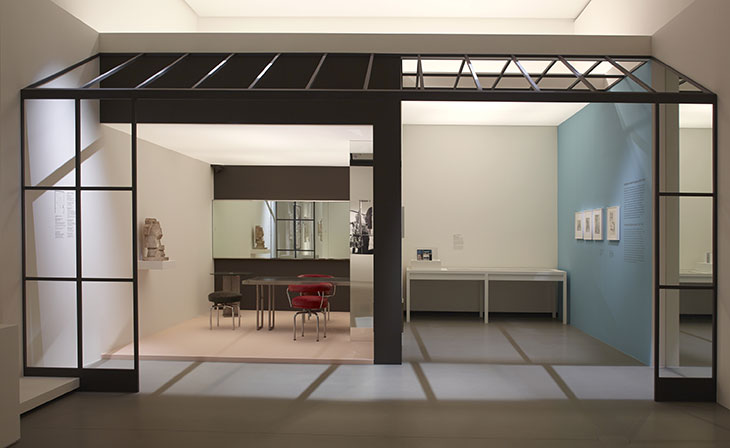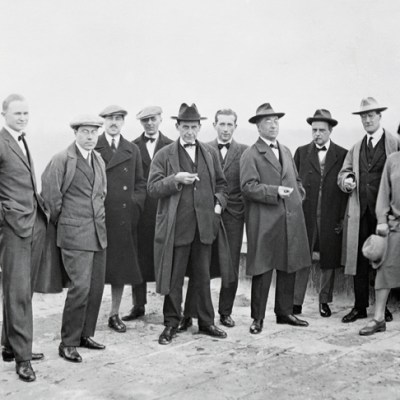Although Charlotte Perriand’s achievements were handsomely documented in 2005 in a fine exhibition at the Centre Pompidou, the 20th anniversary of her death makes a celebration of this multi-talented designer appear timely. Here was a woman who succeeded triumphantly in a male-dominated world – initially as a member of Le Corbusier’s atelier, then, having left it in 1937 (partly for political reasons), forging her own career, working at the cutting edge of modernism throughout her long, productive life. At Fondation Louis Vuitton, ‘Charlotte Perriand 1903–1999: Inventing a New World’ is an ambitious exhibition with a central overarching argument: that Perriand was a designer who brought together fine art, architecture and design.
This she undoubtedly did, most notably in her exhibition ‘Proposal for a Synthesis of the Arts’, held in Tokyo in 1955. The introductory room of ‘Inventing a New World’ makes the case by juxtaposing an Alexander Calder mobile, Black Blue Red (1954), Le Corbusier’s tapestry Les Mains (1951), Fernand Léger’s monumental Le Transport de Forces (1937) and Picasso’s large painting Femmes devant la Mer (1956) with Perriand’s swivel armchair, the chaise longue she designed with Le Corbusier and Pierre Jeanneret, her plywood ‘Ombre’ chair of 1954, designed for manufacture in Japan, and her sheet-aluminium stackable table of 1953.
In the first gallery proper, however, we get Perriand undiluted, with a reconstruction of the studio apartment on Place Saint-Sulpice designed by Perriand in 1927 for herself and her first husband, Percy Scholefeld. An atmospheric photograph shows Perriand standing at the window of the apartment with the Swiss architect Alfred Roth, wearing a necklace made of ballbearings. With her gamine haircut and boldly patterned dress she appears the epitome of hopeful modernity. Two examples of her 1927 swivel armchair, later manufactured for Perriand in the early 1930s by Thonet, are seen with her exquisite extendable dining table with a black rubber tabletop, now in the Centre Pompidou. Tellingly the swivel armchair has only relatively recently been ascribed to Perriand alone. Its confident use of tubular steel, inspired by designs by Marcel Breuer and Mart Stam, suggests that Perriand very likely led the way when subsequently she, Le Corbusier and Jeanneret joined forces.
Perspective drawing of the studio in Place Saint-Sulpice, designed by Charlotte Perriand and published in L‘Art international d’aujourd’hui (vol. 6, Intérieurs) in 1929. © AChP; Adagp, Paris, 2019

Reconstruction of the studio in Place Saint-Suplice, designed by Charlotte Perriand in 1927–28. Installation view at Fondation Louis Vuitton, Paris, 2019. Photo: Fondation Louis Vuitton/Marc Domage; © Adagp, Paris, 2019

We are not able to enter this seductive but intensely practical space which, archival photographs show, was larger and airier in actuality. But this is the first of many room settings and ensembles that enable us to experience key moments in Perriand’s career. For instance, we are able to walk within the single-room apartment that Perriand, Le Corbusier and Jeanneret created for the 1929 Paris Salon d’Automne. Under the rubric ‘Des casiers, des sièges, des tables’ the open-plan layout introduced now-famous designs made by the trio. The decision to recreate the Salon d’Automne space and to give us, the public, access means that all the furniture in this room-setting takes the form of éditions contemporaines by Cassina, the only firm currently authorised to manufacture furniture designed by the trio. (Throughout the exhibition, Cassina and the Milan firm Sice Previt have created new examples of pieces that no longer exist.)
The results are fascinating but also slightly alarming. There is no doubt that an object made as a much later edition or reproduced in 2019 as a painstaking one-off has a different aura to something made in the 1920s or ’30s. So are we in danger of losing sight of the ‘real’ Perriand among later licensed versions of her work, remakes of lost originals and the yet more controversial recreation of designs that never got beyond the drawing board? Sometimes the decision to reconstruct works well. To see and to enter Perriand’s Maison au bord de l’Eau of 1934, made in 2013 by Sice Previt for Fondation Louis Vuitton, or to climb into Perriand and Jeanneret’s Refuge Tonneau mountain shelter of 1938, also never built, but made here by Cassina, comes as a bonus.
Then again, Perriand’s period in Japan from 1940 until 1942 is one of the most obscure yet fascinating episodes in her career. Little survives from the project that culminated in her exhibition ‘Selection, Tradition, Creation’ staged in Tokyo in March 1941. She was invited just before the fall of France, going with the encouragement of Léger, sailing from Marseille on 26 June. The complex and often uncomfortable situation Perriand faced in a Japan about to sign a pact with the Axis Powers in Europe is brilliantly discussed in an essay by Yuko Kikuchi in this exhibition’s excellent catalogue. That Perriand’s work was intended to contribute to Japan’s imperialist Greater East Asia Co-Prosperity Sphere does not detract from her sensitivity to craft and to indigenous materials like bamboo, exemplified by her remake of the Perriand/Jeanneret/Le Corbusier chaise longue from the Centre Pompidou.
Installation view of ‘Selection, Tradition, Creation’, an exhibition of Charlotte Perriand’s work in Tokyo in 1941. Photo: © Francis Haar/AChP; Adagp, Paris, 2019

The recreation of her Maison du Jeune Homme of 1935 also stands out. The room setting – a study and a gym – was created in collaboration with Le Corbusier and Jeanneret for the Brussels Exposition Universelle, signalling Perriand’s turn to craft and the vernacular well before her visit to Japan. Her political engagement with the Left in the 1930s is also made manifest by the remakes of her large-scale photo montages, while at a more private level there are her marvellous photographs of objets trouvés. After the Second World War, left-wing politics continued to sustain her as did her contact with mountain culture and sport. These interests were combined in the Les Arcs ski resort from 1967 to 1982, for which she designed uncompromisingly modern blocks ingeniously built into the mountainside. The complex intended for ‘the people’ was modestly but ingeniously furnished, an egalitarian model for winter sports that was not to survive into the 1990s.
Perriand’s origins were humble, with rural and artisanal roots. She comes across as tough but joyful, able to make the best of any difficult situation. She might be surprised by the lavish nature of ‘Inventing a New World’. For example, the decision to give space to Perriand’s redesign of the apartment of the collector Maurice Jardot (1978) and of Galerie Louisa Leiris (1989) ends up highlighting quantities of blue-chip School of Paris painting. Context is all. In the lush pastures of the Fondation we may struggle to develop a period eye that properly appreciates the willed austerity of heroic modernism and the pared-down modesty of objects that are now deemed ‘design classics’. But if historical exhibitions seek to capture the past, they also, paradoxically and disarmingly, offer a record of present-day dreams and desires.
‘Charlotte Perriand 1903–1999: Inventing a New World’ is at Fondation Louis Vuitton, Paris, until 24 February 2020.
From the November 2019 issue of Apollo. Preview and subscribe here.



